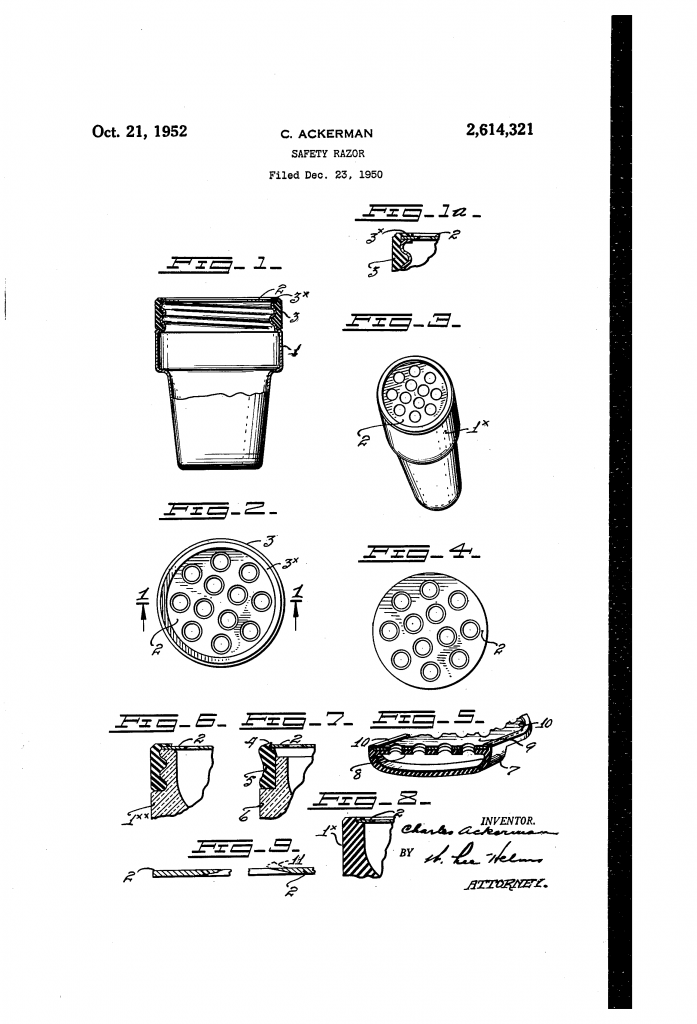Most inventions have a point to them. Charles Ackerman’s patent, filed in the last days of 1950, could be said to be an exception. It is a safety razor that can being described at being all edge and no point.
And honestly, that is not a bad thing. No point means less chance of nicking oneself on the corner of a blade. So let’s have a look at how a razor can be all edge and no point.
For starters, Charles’ razor used a round blade. Which is similar but not identical to the blades used by the Shermac razors of the 30’s. Where it differs is that Charles’ razor used a number of holes in the blade as the edge, as opposed to the outer rim. It was a rather novel idea, and in the words of the patent:
The object of the invention is to provide a novel type of holder and blade which will be particularly adaptable for a dry or soapless shave, which will have a shaving action with improved closeness of shave without cutting the skin of the user, which will have a greatly enlarged cutting edge area commensurate with the over-all area of the blade, and which, in a preferred form of the invention, will provide a yielding carrying area for the blade which area may include surfaces disposed marginally of the blade and which have immediate contact with the skin to have a smoothing and straightening action upon the skin forwardly of the cutting action. By reason of the invention it is almost impossible to cut the skin in all normal operations of the razor.
From US patent 2,614,321

As can be seen from the drawing the round blade have a number of holes in it. Each hole is ground to an edge. There is no real need for a safety bar or other guard. The opposite side of the hole will prevent cutting of the skin.
There is no top cap or bottom plate as we know it from more traditional razors. Instead there is a handle in the form of a hollow shell, made out of plastic or metal. On top of this is a blade holder, made by rubber or other yielding material. The blade holder holds the blade against the handle.
The flat of the blade is rubbed against the stubble, and the beard crumbs will collect in the handle. This is likely why Charles suggested a soapless or dry shave – there is no easy way to clean the razor without taking it apart.
Figure 5 shows a variation of the invention. This takes the form of a larger plate with a strap on the back, that could be strapped onto the hand. And then, I assume, be rubbed all over the face as a cheese grater.
Charles also described the use of his razor. To qoute:
In any of the forms of the invention, the blade may be moved by the holder in sweeping strokes, the cutting action being in all directions of such strokes, and I have found that combined sweeping and oscillating motion of the holder as very effective. In the preferred form of the holder, its yielding peripheral margin serves to position the skin for the face shaving action of the blade and also to serve as a massaging implement. As hereinbefore stated, the device is fully operative in shaving without soap, and a close shave is secured thereby.
From US patetn 2,614,321
I see no reason why Charles all edge and no point razor shouldn’t work as well as most other safety razors for a dry, soapless shave. Apart from not liking the idea of a shave that isn’t wet, I see no major issues with it.
The full patent can be read at Google Patents.

Pingback: Shaving device having multiple cutting edges - Wegian WetshavingWegian Wetshaving
Pingback: All edge and no point - Razors n Blades the shave that saves
Pingback: Spherical razor - Wegian WetshavingWegian Wetshaving
Pingback: Cylindrical safety razor - Wegian WetshavingWegian Wetshaving